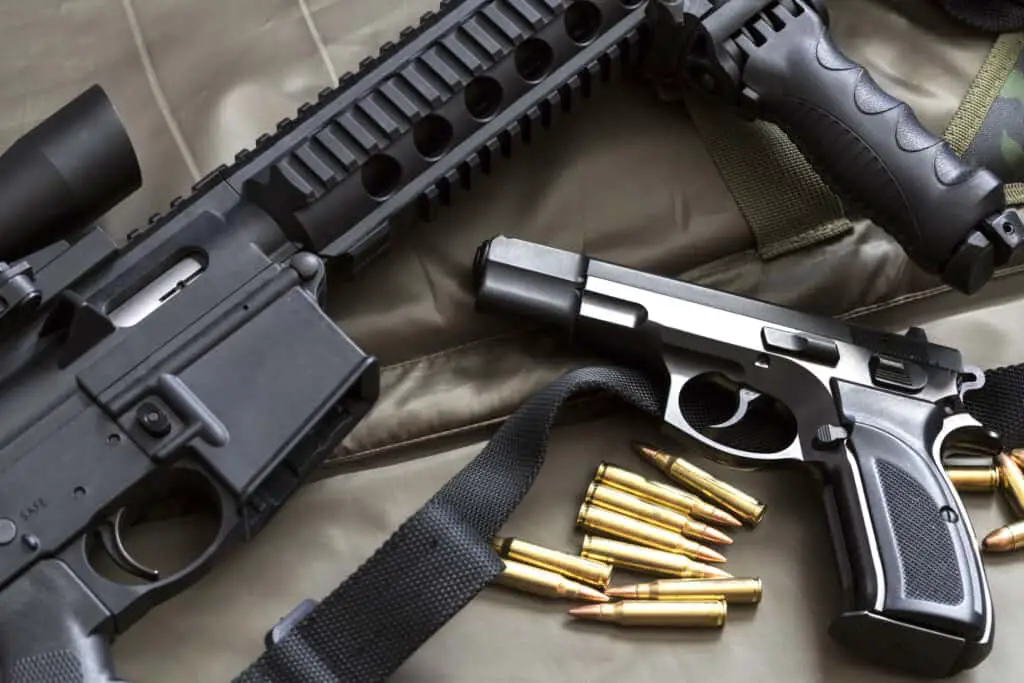
Going to a shooting range and firing off a couple of rounds is a fun activity that many people enjoy. But you know what? Getting to know the different gun types can be a bit tricky because of the seemingly infinite variety you encounter. In reality, there are three main styles of guns. That being said, there are variations within each. In this article, we’ll break down the three types and then dive into their variations. Therefore, the next time you are out with your friends talking about guns, you’ll be more informed.
The 3 main types of guns are:
- Revolvers/Handguns
- Shotguns
- Rifles
All three styles of guns have several sub-categories they can be broken into. Let’s take a closer look at the main sub-categories. Then show you their names and pictures to make you better at identifying them.
Gun Types and Descriptions
A lot of people get confused about the specific type of gun they are holding and how they work. With so many moving parts that make up the firearm, as well as the different ammunition designs and purposes, it can be overwhelming.
What can help is knowing the name of, and understanding the function of, the basic parts of every firearm. All firearms have three basic parts. These are the action, the barrel, and the stock. Think of the action as the heart of the firearm. This is where everything important and complex happens. The action is where your cartridge (bullet) is loaded, fired, and ejected.
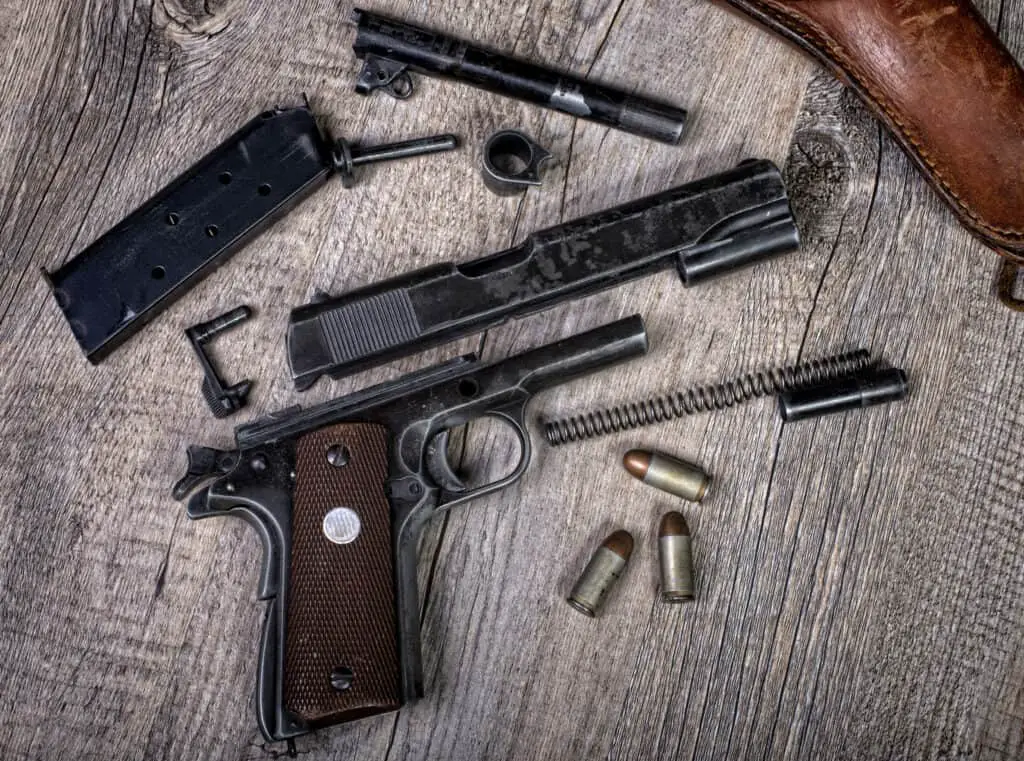
As for your barrel, this is the metal tube that your bullet travels down. The bullet is projected down the barrel, usually by gunpowder or compressed air. The barrel also acts as a guide to point, aim, and direct the bullet.
The stock supports the barrel and action. It’s where you hold the firearm, allowing you to support and aim the firearm while you pull the trigger. With rifles and shotguns, the stock is pressed against your shoulder, with one hand going on the trigger and the other holding the forestock (the area directly beneath the barrel). These three points of contact (two hands and your shoulder) make rifles and shotguns easier to aim. With handguns and revolvers, one or both hands hold the stock (grip) to use the weapon.
These are the basic parts that will be mentioned throughout this article. The different types though are built differently so, therefore, each will have different features. As I explain each gun type, I will also mention more parts specific to that gun, but I will make sure to explain the part in better detail.
Revolvers
Both revolvers and handguns are designed to be aimed and fired with one or two hands. They each have an action, stock (in this case called a grip), and a barrel. That being said, they have specific differences that set them apart from each other.
The primary difference is that revolvers have a cylinder with multiple chambers. Each chamber holds a single cartridge. As you pull the trigger, the cylinder rotates. With each rotation, a different chamber is aligned between the barrel and the hammer. Like most guns, a revolver can be built to shoot different calibers (bullet type defined by its length, shape, and diameter), thereby creating even more variety.
Revolvers are further defined by their action. This is the mechanism by which the hammer moves and the cylinder rotates.
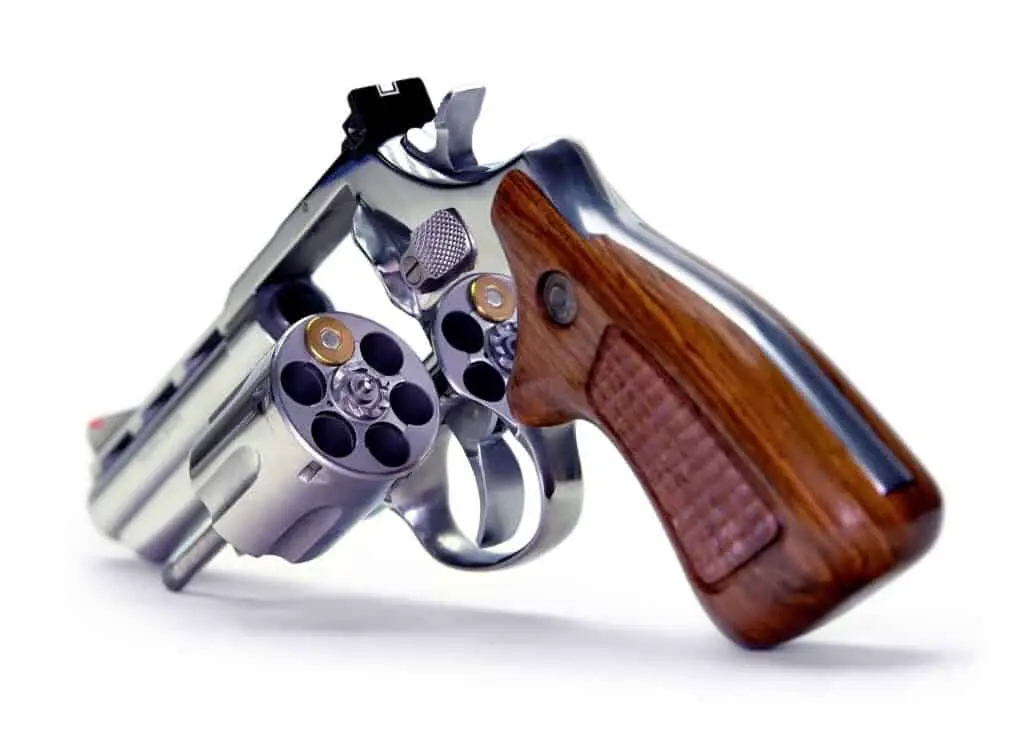
There are different types of revolvers:
- Single-Action: In a single-action gun, pulling the trigger does one thing, and one thing only. Pulling the trigger releases the hammer causing it to strike the primer of the cartridge. With single-action revolvers, the hammer must be pulled back manually before pulling the trigger. It is the act of pulling back the hammer that rotates the cylinder and cocks the hammer, making it ready for the trigger to release the hammer and the revolver to be fired. Because only one action is accomplished by the trigger, the pressure required to actuate the trigger is generally light, and the movement required is generally short.
- Double-Action: The trigger in a double-action gun carries out two physical functions. First, it rotates the cylinder and cocks the hammer. The second action is the release of the hammer. As there is more mechanical action in a double-action trigger, two things can be noticed. First, the trigger pull length and effort required are greater than that of a single-action trigger. Second, there tends to be a breaking point of the trigger. At this point, the cylinder has been rotated fully and the hammer has been cocked. Any further pull will release the hammer. As you gain experience shooting this type of trigger, you will learn where this break is and will be able to “stage” the trigger at the break. One quick note, a double-action revolver can be staged as a single-action revolver by pulling back on the hammer, setting it to single-action operation.
- Double-action only (DAO): A DAO revolver is similar to a double-action one with one minor difference. In the DAO revolver, the hammer is either concealed within the frame or is modified such that the thumb spur (the part of the hammer that you can grip and pull back on) is removed. Therefore, there is nothing to press down on (with your thumb) to stage the hammer as you would with a single-action revolver.
As a beginner shooter, you might prefer a single-action simply for the fact that it does not require a lot of effort to pull the trigger. Whereas with the double-action revolver, more pressure and travel length will be needed for the trigger. During the long trigger pull of a double-action revolver, the revolver can move around making it harder to hit a target.
People who have a concealed-to-carry permit prefer the DAO revolver because of the “hammer-less” feature. Without a hammer spur, it is easier to draw the revolver out of a purse or holster in self-defense as there is no hammer spur to snag. Source
One of the most popular entry-level choices for a revolver today is the Taurus 905 chambered in 9mm. This gun starts new at around $400 making it a great first buy. The best price we’ve found on this gun specifically can be found here.
Handguns
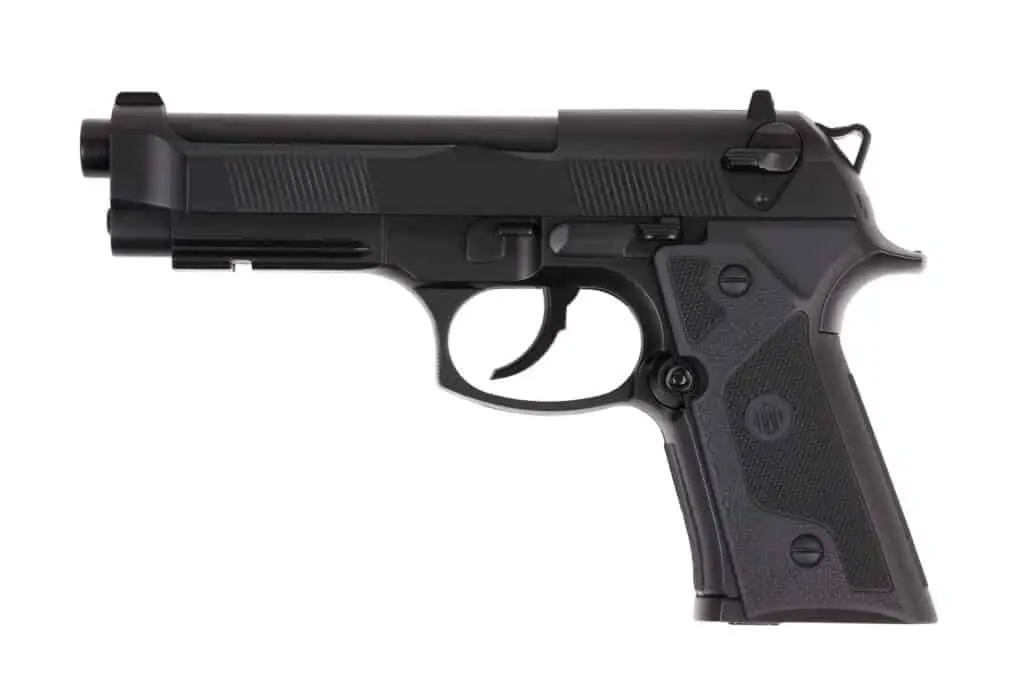
Handguns, unlike a revolver, do not have a cylinder containing multiple chambers. Handguns, and more specifically semi-automatic handguns, have a single chamber, that cartridges are fed into via the mechanics of shooting the handgun. As the trigger is pulled and the firing pin impacts the primer and the resulting explosion and recoil causes the slide to move backward ejecting the spent round and chambering a new round.
The new rounds are stored in a detachable magazine. The number of rounds stored in the magazine depends on the caliber of bullets and the size of the grip. Magazines can either be single stack (one column of cartridges) or double stack (cartridges are stored “side by side” in the magazine). Depending on the caliber, single-stack magazines usually store 5-10 rounds while double-stack magazines can store 10-20 rounds or even more. The “cost” of a double-stack magazine is that they are thicker and can be more difficult to conceal.
Handguns and revolvers, both being small firearms (e.g., smaller than rifles or shotguns) are perfect for conceal carry. Chambered for a defensive round (e.g., 9mm, .45 ACP, etc.) they carry a strong punch, and, in the right hands, they can be extremely accurate.
The bore of a handgun, most revolvers, and rifles, contain spiral groves (e.g., also called rifling) that impart a spin on the bullet. This spin stabilizes the bullet and aids in accuracy. Source.
As with most guns, handguns come in a variety of sizes. These are generally full-sized, compact, sub-compact, and micro-compact/pocket pistols. Let’s look at these different types of handguns.
- Full-Sized: Full-sized handguns are the largest standard handgun size available. They feature barrels that are 4.5 inches or longer. They are also large enough to comfortably fit your whole hand on their grip, although some people with smaller hands may find them difficult to hold and control. The Glock 17 (double-stack magazine) and Colt 1911-patterned handguns (most use single-stack magazines) are popular full-sized handguns.
- Compact: Compact handguns have shorter barrels ranging from 3.5 inches to 4.5 inches. Their grip can be as large as a full-sized pistol or slightly shorter. These include pistols like the Glock 19 and the Sig P320 compact.
- Sub-Compact: Sub-compacts are even smaller than compact pistols. They have barrels that are 3.5 inches or less. The grip of a sub-compact is much shorter and may only fit two fingers comfortably. The Glock 26 and Taurus G3C 9mm are examples of popular sub-compact pistols.
- Micro-Compact/Pocket Pistol: Pocket pistols are designed for the deepest concealment and have been around for a very long time. These guns have barrels less than 3 inches and can easily fit in pockets. Modern examples include the new Springfield Hellcat and Ruger LCP.
Nearly all magazine-fed handguns made today are double-action. If you want a cheaper, but quality handgun, I recommend the Taurus PT111 G2. I purchased this handgun 5+ years ago, concealed carried it for many of those years, and put roughly 3,500 rounds through the gun. I’ve never had any issues with it.
Given that it is just about $250 (https://www.cabelas.com/shop/en/taurus-millennium-g2-semi-auto-pistol) it makes it an excellent choice for a low-budget carry firearm.
If you are looking for a higher-end handgun with all the bells and whistles, I recommend the War Poet Pistol. This has been my daily carry for a while now and I’ve never owned a better handgun.
Rifles
Rifles are designed to use both hands to shoot accurately, with the stock being positioned against the shoulder. The barrel must be over 16 inches long and the bore will have rifling as well.
The ATF (The Bureau of Alcohol, Tobacco, Firearms, and Explosives) defines your everyday rifle as “…a weapon designed or redesigned, made or remade, and intended to be fired from the shoulder and designed or redesigned and made or remade to use the energy of the explosive in a fixed cartridge to fire only a single projectile through a rifled bore for every single pull of the trigger.” (Source).
The ATF also further defines a Short-Barreled Rifle (SBR) as a rifle with a barrel length under 16 inches. To own an SBR you must be compliant with additional federal and local laws.

There are varying types of rifles, and these are:
- Lever-Action Rifles: Lever-action rifles were one of the earliest rifle designs. When you think of a cowboy out in the wild west, this would be the type of gun he’d carry. With this rifle style, the magazine is a tube directly beneath the barrel. The oversized trigger guard acts as a lever that is rotated toward the front of the barrel. During this action, the old shell is extracted and a new one is chambered. The hammer is also cocked making for a light trigger pull. Lever actions have had a recent resurgence, especially as suppressed “tactical” firearms. Partially as a joke, but partially because they suppress very well.
- Bolt-Action Rifles: Bolt actions are very popular rifles. They are produced in large quantities and are known for being easy to use and for their accuracy. The bolt consists of a metal shaft that contains the firing pin and locks the round into the chamber. The bold handle sticks out from the bolt and allows the shooter to manually operate the action. With four motions of upward, backward, forward, and down the firearm ejects the last spent casing, loads the next cartridge, and then locks the chamber closed, readying it for fire. From there you just pull the trigger. For each shot, the shooter must execute these four moves. Since bolt actions have no moving parts during firing (with the exception of the trigger and firing pin) they can be very, very accurate.
- Semi-Automatic Rifles: Semi-autos eliminate the need for manually loading a cartridge into the chamber. The recoil and/or gas generated by the cartridge provides the energy to manipulate the action. This allows the shooter to fire one round with each pull of the trigger. Most semi-automatic rifles use either an internal or detachable magazine for storing the ammunition.
- Break-Action Rifles: Break-action rifles are unique in that they seem to partially break in half at the chamber. By pulling on the action release, the gun hinges open like a door, and from there the shooter manually loads and unloads the cartridges.
- Air Rifles: Air rifles utilize compressed air instead of an explosive propellant to launch their projectiles. The pressure is either manually pumped or provided via external pressurized gas. The different types of air rifles include spring-powered, gas piston, pre-charged pneumatic (PCP), variable pump, and CO2-powered. Most air rifles do not require the same licensing as rifles that use gunpowder cartridges.
The AR-15
The AR in AR-15 does not, contrary to common belief, stand for ‘assault rifle’, but instead is named after its original manufacturer, Armalite. The civilian AR-15 is exclusively a semi-automatic rifle, immediately disqualifying it from being an assault rifle, and if you try to convert this weapon to an automatic weapon, you will land yourself in prison.
There are three primary parts to the AR-15. There is the upper receiver, then the bolt carrier group, and then the lower receiver. The upper receiver includes the barrel and the bolt carrier group and can be separated from the lower receiver by removing two pins. Pushing out the rear pin out allows you to tilt the upper receiver forward so you can clean it. Pushing out both pins separates the upper from the lower. The lower receiver contains the stock and trigger.
AR-15s come in two main types: direct impingement and gas piston.
Direct Impingement: When you pull the trigger the propellent releases gas and moves the bullet down the barrel. A little gas is released through a small hole in the barrel where it travels down a tube back to the bolt carrier. The gas assists the bolt carrier, coupled with the recoil from the cartridge to eject the spent casing. Once the casing is ejected the buffer spring within the stock’s buffer tube, pushes the bolt carrier forward stripping a new round and chambering it.
Gas Piston: This has a similar start to the propellant gas feeding through a small hole in the barrel. The main difference here is that a small piston directly contacts the bolt carrier group and cycles it backward. As the piston moves, the bolt carrier is pushed back, extracting the spent round and reloading the next one.
If you are looking for an entry-level AR15 that is well built, I recommend the Ruger AR-556 chambered in either 5.56 or 300blk. I chose the 300blk version. One note, 300blk ammunition is harder to come by and nearly twice the price however, it suppresses very well. You can pick up this gun for under $700 here: https://palmettostatearmory.com/ruger-ar-556-free-float-300-blackout-ar-15-rifle-black-8530.html
Shotguns
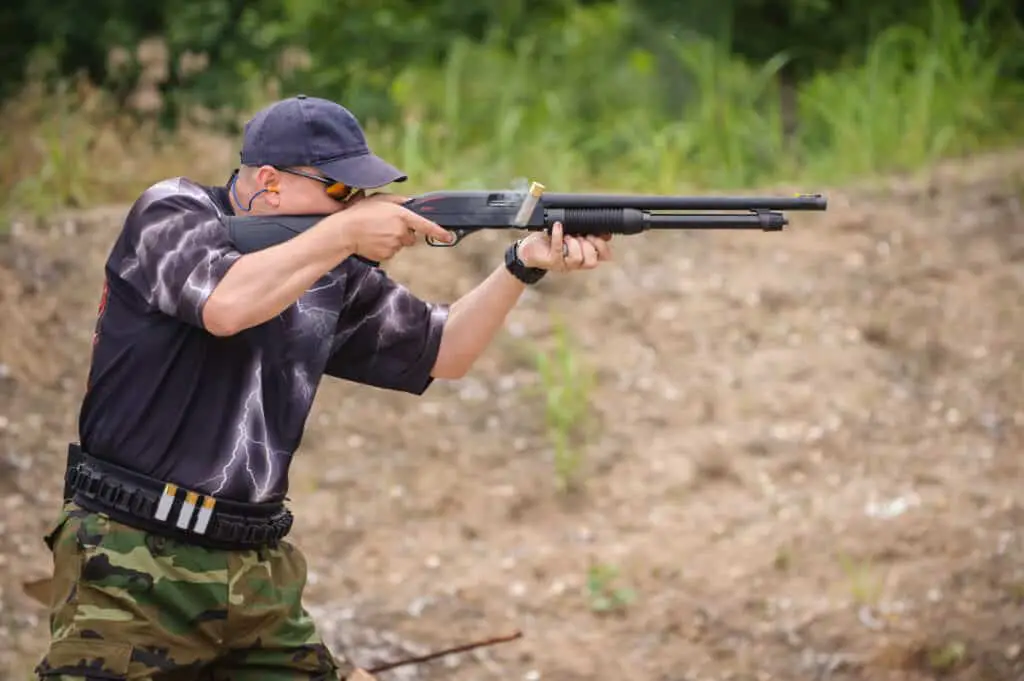
Similar to the rifle, this weapon is meant to be shot from the shoulder with a barrel that is, at minimum 18” long. But where the rifle has a rifled bore, the shotgun has a smooth bore with thinner walls. Specialty shotguns may have a rifled barrel (such as a rifled slug fun). The smooth bore reduces the friction and thicker walls are not as necessary because less pressure is seen here.
The uniqueness found with shotguns is that, unlike the rifle or handgun where only one projectile is used, the shotgun can fire multiple projectiles called ‘shot’. The shot explodes from the gun and spreads out as it travels. The farther the distance, the greater the spread of the shot. These guns are short-range because the power is split between the multiple shot and therefore the shot loses its energy quickly as it travels.
Like rifles, there are multiple types of shotguns. The types include break-action, lever-action, pump-action, and semi-automatic.
- Break_Action: Break-action shotguns are the simplest type of shotgun. They have one, two, or even three barrels side-by-side or over-under and have their shells loaded in by hand when the gun is broken open. Single barrel break action shotguns are good beginner guns since they only accept one shell at a time and are inexpensive. An example of a break-action single barrel shotgun is the Henry Single Shot Youth Shotgun.
- Lever-Action: Lever-action shotguns are similar to lever-action rifles. A lever on the bottom of the gun is used to put the next shell in the action, but instead of a rifle round, it is a shotgun shell. These types of shotguns have fallen out of popularity except in areas where they are the only legal option. The Henry Lever-Action .410 Shotgun is an example of a modern lever-action shotgun.
- Pump-Action: Pump-action shotguns are the most common shotgun type today. They carry multiple shells in a tube magazine under the barrel. The shells are chambered by pulling back on the forestock and then pushing the forestock forward. This motion ejects the spent shell and chambers new ones as long as there is ammunition in the magazine. The Mossberg 500 and Remington 870 are good examples of pump-action shotguns.
- Semi-Automatic: Semi-auto shotguns work in the same way as semi-automatic rifles. They take some of the gas and recoil from the propellant to chamber the next shell. These types of shotguns are becoming more popular but have slightly different controls than those found on a pump-action shotgun. The Beretta 1301 is an example of a semi-automatic shotgun.
For home defense, a simple 12-gauge security shotgun is tough to beat. I believe a good 12-gauge should be in every home. I recommend the Mossberg 930 Security shotgun with an 8-round capacity. It’s slightly higher priced than their lower-end Mavrik line, but the quality difference is noticeable. You can pick one up here for just over $700.
Machine Guns
First, let’s clearly define semi-automatic and automatic firearms. Semi-automatic means that the firearm fires only one bullet per pull of the trigger. An automatic firearm fires multiple rounds (2,3, or all the ammo in the gun) as long as the trigger is pulled.
The difference in their operation is determined by their specific parts. First, at the barrel’s chamber, closest to the trigger, is the bolt and firing pin. The firing pin strikes the cartridge’s primer, the primer ignites the powder which propels the bullet out of the barrel.
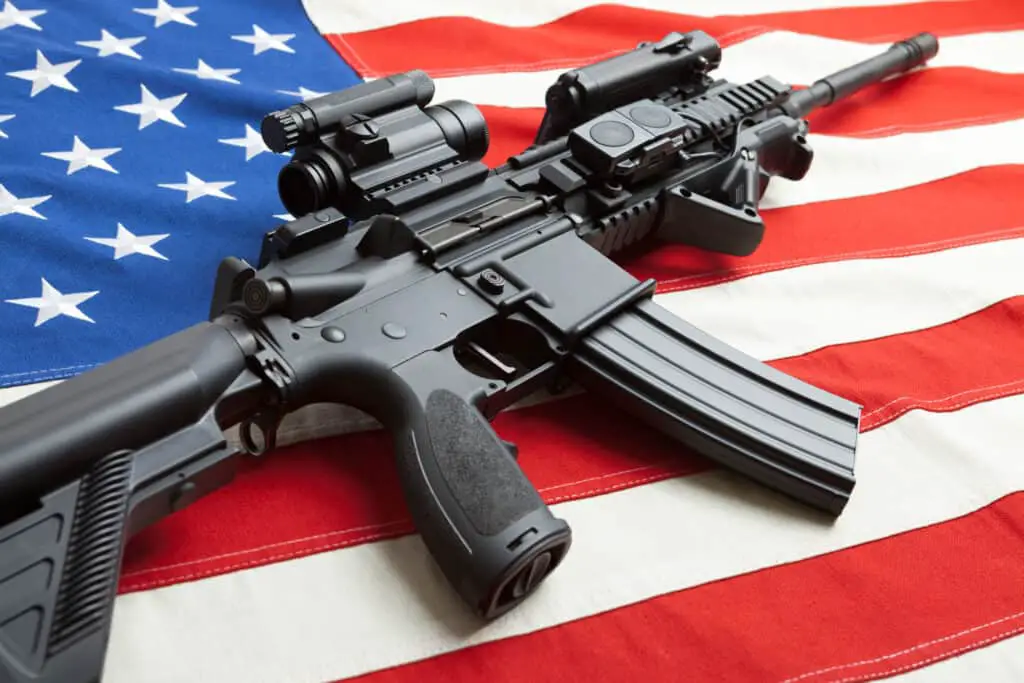
The second part of interest is the buffer spring. This spring absorbs the recoil of the bolt which ejects the spent casing after the bullet fires. The buffer spring then pushes the bolt forward loading another bullet into the chamber. The gun is now ready to be fired again. During this cycle, the trigger, hammer, sear, and disconnector work together to ensure that the timing of trigger pull, and hammer fire the bullet only when it’s chambered. Source
Machine guns work by allowing the gun to fire as soon as a bullet is chambered. The bolt, sere, and hammer are specifically designed to support automatic fire. Therefore they are also controlled and licensed.
To be able to legally own any fully automatic weapon in the US, the firearm must be manufactured before 1986. However, newly manufactured firearms can be legally converted to a legal machined gun with the appropriate paperwork and approval of the ATF and the receiving of a tax stamp. Automatic firearms are highly restricted in their ownership. The pre-1986 requirement only applies to transferable or sellable machine guns in the US. Assuming you live in a state that allows them, are willing to file the paperwork, wait a long time for it to clear, and pay A LOT of money, you can own a pre-1986 machine gun.
Legally, a machine gun is any fully automatic weapon. However, there are several types that meet the legal definition but are categorized differently in design and practice. These are: submachine guns, heavy machine guns, light machine guns, and assault rifles/select-fire rifles.
I will cover assault rifles by themselves so let’s look at the three other types.
- Submachine Guns: Submachine guns are automatic weapons chambered in a pistol or handgun caliber (e.g., 9mm, 10mm, .45 ACP). Early versions of these types of guns are sometimes called machine pistols but later the term machine pistol would only apply to handgun-sized automatic weapons. Many submachine guns were designed and manufactured before 1986 making them highly sought after by collectors. Examples of early submachine guns are the American Thompson submachine gun and the British Sten series of submachine guns.
- Heavy Machine Guns: Heavy machine guns are some of the earliest types of machine guns for military use. They are harder to move and are generally mounted to a carrier or bipod/tripod. When fired continuously they produce a lot of heat which requires cooling to prevent damage. This is done with a water jacket or air cooling. Both methods attempt to dissipate heat quickly to prevent the barrel from melting. Most heavy machine guns use a belt instead of a magazine to feed into them as their rate of fire is much higher than a normal rifle and a typical magazine won’t last long. Other times the machine gun’s bullets are bigger than a normal rifle and magazines for bullets of that size are not practical. Examples of heaving machine guns are the Browning M2 heavy machine gun and the Maxim gun.
- Light Machine Guns: Light machine guns are meant to be carried by a single person or by a small team. They use rifle bullets in a belt or sometimes in a magazine. Older types of light machine guns became popular during the World Wars and are highly collectible. More modern-made light machine guns are belt-fed only and harder to collect. Examples of light machine guns are the Lewis gun and the American M60.
Assault Rifles
Assault rifles differ from machine guns in that they have the option of a semi-automatic mode, a three-shot burst mode, and/or an automatic mode. However, assault rifles are also classified as machine guns because of their automatic firing capacity.
The military M4 is a good example of an assault rifle, as military versions can have an automatic setting as well as a semi-automatic setting. To fire this gun, first move the selector switch from safe to either semi-auto or automatic, and press the trigger. Based on the selector switch the M4 will either fire one round (semi-auto) or multiple (auto).
The video below does an amazing job at showing how AK-47’s and other assault rifles work:
Wrapping Up Gun Types
Some people spend years learning the intricacies of the widest array of firearms possible. From antiques to the latest generation of firearms. You don’t have to understand the minutia of all firearms to enjoy the hobby or to defend your family. What is important is the knowledge of the safe operation of any firearms you own and the accurate use of them. Everything else is a bonus.
OUR RECOMMENDED TACTICAL GEAR LIST:
- Best Health and Fitness Tracker, Whoop. Get 1 Month Free: See it here!
- EDC Assisted Opening knife we can’t live without: See it here!
- Best EDC Concealed Carry Pistol: See it here!
- Extreme Performance Morning Dink: See it here!
- Best 3D Printer For Gun Parts and Accessories: See it here!
- Our Top Rated EDC Flashlight: See it here!
- AR Red Dot Sight We Can’t Live Without: See it here!
- Best Handgun Safe For Quick Access: See it here!
- Top Wireless Security Camera For Home Security: See it here!
- The Range Bag You’ve Always Been Looking For: See it here!
- CIA Approved Sharp Shooting Course: See it here!

